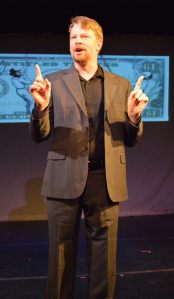Summer is a time for carnivals, and for sitting indoors contemplating culture, and for once I didn’t have to choose, with the Money Lab attraction running through August 10 at Brooklyn’s Brick Theater. Billed as “an economic vaudeville” and charged (heh) with both comprehending the current financial structure of our society and considering the relative “worth” of the arts, the workshop-in-progress version is both a variety show and participatory gameshow, with sketches and performances alternating between interludes of audience auctions and John Nash-style theory games with volunteers from the crowd.
 The entertainment and exercises are MC’d by an erudite and enjoyable Clive Dobbs as a kind of Alex Trebek who’s actually as smart as he thinks he is; the games were designed by economist Rosemarie Nagel with Money Lab originator Edward Einhorn and curator of the same theatre’s recent “Game Play” festival, Gyda Arber.
The entertainment and exercises are MC’d by an erudite and enjoyable Clive Dobbs as a kind of Alex Trebek who’s actually as smart as he thinks he is; the games were designed by economist Rosemarie Nagel with Money Lab originator Edward Einhorn and curator of the same theatre’s recent “Game Play” festival, Gyda Arber.
I learned a lot from these scenarios, and it’s sociological news not theatrical criticism since none of these outcomes will exactly ever happen again. In the one where an audience-member is required to calculate what percentage of his plastic tokens (redeemable for art-expressions like books and posters or material necessities like candy at the show’s on-stage midway) he should give to another audience-member, an assumption is made about the second man’s affluence, causing the first contestant to offer a 70/30 split (keeping the 70). The supposedly richer guy rejects it, proving to me that having more is what causes us to expect more (not that 50/50 would automatically ever be enough for anybody, or that a “poorer” player wouldn’t have happily taken 20).
In a later game where one player has to decide whether to give all or some of his tokens to the other out of sheer altruism, the supposedly poorer participant played on the other’s apparent hesitancy to give away any, ad-libbing, “You look like you need it more,” thus shaming him into giving them all — a lesson in the internal peer-pressure of our own self-image (though somehow this guilt variable seems to have been factored all the way out of today’s real-life rulers of the world — sure works on the streetcorners and crowdfunding sites we other-99 fight over, though).
A running purpose of the evening was to see whether the “necessities” or the spiritually enriching art products were more valued. In the performances, these worlds were pooled, as in a dance set to the news-cycle psychobabble of the late-aughts collapse, “Dead Cat Bounce,” created by Einhorn and Patrice Miller with smart contorted clockwork choreography by Miller. (I was already a fan of dancer Stephanie Willing’s commanding kinetic storytelling and tend to concentrate on her ring of the circus, but there was great personality and expressive authority from the whole, um, company — also featuring Kayla Eisenberg, Laura Hartle, Jenn Purcell and Ruri Saito.) When some things can’t be made sense of, art can make spirit-lifting nonsense out of them, and this performance was an invocation to see the absurdity that can bring certain assumed realities into perspective.
Divining understanding from the cacophony of ostensibly assured or reassuring public scripture, Ian Hill created “NECROPOLIS 6: To Receive a Mark (a sea of glass),” a one-person found-text oration in which he played a Hall-of-Presidents-robot version of discredited economic prophet Malthus, shortcircuiting between the dogged pessimism of his own recited writings and the blind optimism of an old World’s Fair march-of-civilization slideshow playing onscreen, with drowning-out popsongs and vindictive ecclesiastical voiceovers to unfairly compete. Hill gestured hilariously and jerked uncomfortably like a macabre marionette pulled in contradictory directions by at least one invisible hand, for the most meaningfully scary clown performance I’ve seen since the golden days of Flavor Flav.
“Dead Cat Bounce” had been a type of ritual in which thoughts are imposed from without rather than ideals raised from within; in “The Money Atheist,” a bizarre self-help sermon (written by Einhorn and delivered in epicurean histrionics by Emily Alpren), the speaker recounts how she learned to stop worrying and accept that the completely abstract art of paper money and performance piece of stock-market numerals seal in actual value and direct life and death. Both finance and art are consensual delusions, though the former requires acquiescence while the latter is something on which we can all decide to agree. Money Lab offers food for thought that isn’t free, but is indisposable.



